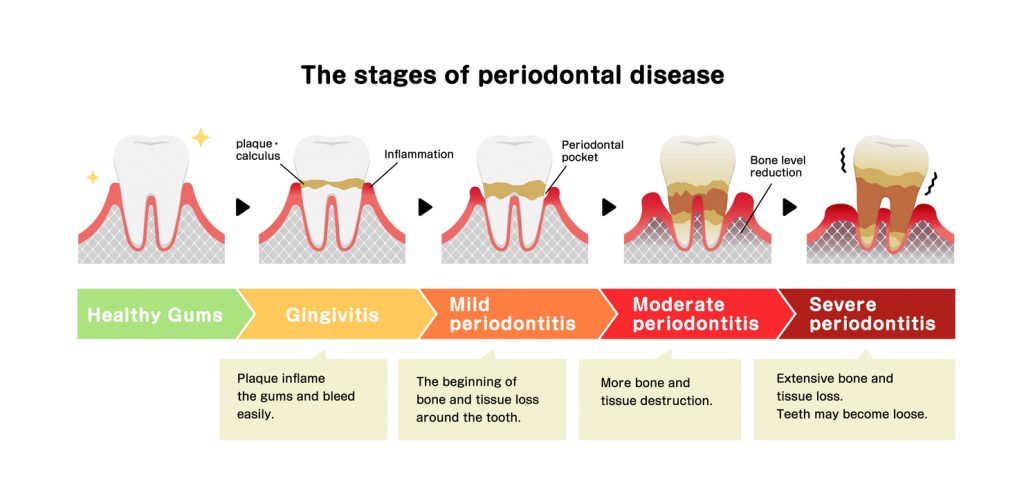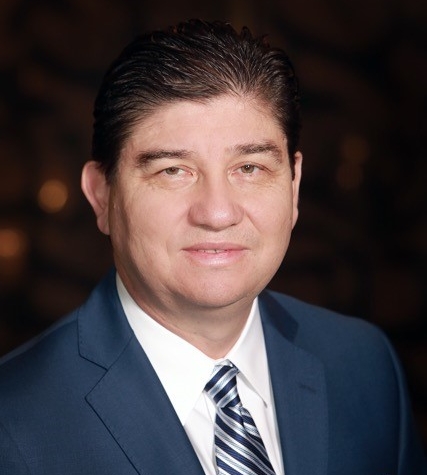Periodontal disease can be quite a serious oral health condition, but the good news is that it can be both prevented and treated. This condition occurs when bacteria infect the gum tissues, causing inflammation, pain, and even bleeding. Treatments involve getting the infection under control before it causes serious and permanent damage.
Stages of Gum Disease

Periodontal or gum disease has four phases. Your treatment options depend on which stage your condition has reached.
Gingivitis
Gingivitis is the earliest stage of gum disease and involves plaque build-up leading to inflammation. The symptoms of gingivitis are typically mild, such as bad breath, swollen gums, and bleeding when you brush or floss your teeth.
You can reverse gingivitis by boosting your oral hygiene routine to tackle the bacteria that are causing your symptoms. Brush, floss, and get regular professional cleanings to get rid of plaque. Your dentist may also recommend using a medicated mouth rinse to kill bacteria.
Early Periodontal Disease
If you do not tackle gingivitis head-on, it is likely to progress into gum disease. During this stage, it is likely that you will feel some tenderness and inflammation in your gums as bacteria settle in. Signs such as bad breath and bleeding are likely to still be present. By now, the plaque on your teeth has hardened into calculus, which you cannot remove yourself at home, so you will need professional cleaning. In this stage, the infection begins to affect the bone structures under the gums, which means you need treatment urgently to prevent bone loss.
Treatments for early periodontitis include scaling, in which a periodontist, like Dr. Trujillo in Phoenix, AZ, uses special tools to remove tartar and bacteria from below the gum line. You might also need root planing, in which the dentist smooths the surface of the tooth root, removing bacteria and making it more difficult for tartar to build up there. In addition, they might prescribe antibiotics, either in the form of a mouth rinse, gel, or pills.
Moderate Periodontal Disease
By the time you reach moderate periodontal disease, bacteria have found a firm foothold in your mouth. You may have noticed that your gums are receding, causing your teeth to look longer than they used to. The newly exposed parts of the teeth can be very sensitive. You might even find that your teeth are slightly loose, shifting position, or feeling wobbly as the disease attacks the bones that support them. There is likely to be a bad taste in your mouth and perhaps even an unpleasant discharge.
In this stage, you urgently need scaling and root planing to bring the infection under control.
Advanced Periodontal Disease
The final stage of gum disease occurs when the infection spreads deeper into the bones. You are now at high risk of bone loss, which can lead to your teeth falling out and even the shape of your face changing. In addition, your gums are likely to hurt, ooze pus, and look red and swollen. Chewing hurts and your teeth feel loose. Before long, they will start to fall out, if they haven’t already.
Advanced periodontal disease requires immediate treatment: a course of oral antibiotics and thorough cleaning to remove as much infected tissue as possible. You might even need surgery.
Treatment Options
Flap surgery is a technique that many periodontists use to expose roots so that they can carry out thorough scaling and root planing. It involves cutting flaps in your gums to expose the lower parts of the teeth and then sewing them back up after cleaning. However, Dr. Trujillo prefers LANAP laser gum treatment as a less invasive and quicker recovery treatment.
Soft tissue grafts can help to treat receding gums. Dr. Trujillo grafts tissue from your palate or another site onto your gums to restore the tissue that has been lost.
Bone grafts are necessary when periodontal disease has destroyed the bone that holds the root of a tooth in place. Dentists can use bone taken from another site or synthetic material.
Guided tissue regeneration is a technique that encourages the growth of new bone, using biocompatible fabric to guide its growth around the tooth.
The sooner you see periodontist, Dr. Trujillo, in Phoenix, AZ, for treatment for advanced periodontal disease, the more chance you have of saving your teeth and protecting your jaw bone.
How to Prevent Gum Disease
Perhaps you do not yet have any serious signs of gum disease. You still need to take action to protect your gums, teeth, and bones. The best way to keep gingivitis and periodontal disease at bay is to have a very strong oral hygiene routine. It should consist of daily brushing and flossing, along with a tooth-healthy diet. Regular dental checkups are equally important as they allow Dr. Trujillo to clean away plaque and look out for any early signs of gum inflammation.
If you are prone to gum disease, then it might be possible to reduce your risk through a procedure such as pocket reduction surgery, which reduces the space that bacteria can infect around each tooth. Pocket irrigation can also help to clean out these pockets to keep them free from bacteria.
Dr. Trujillo’s Treatment for Gum Disease at Arizona Periodontal Group
Dr. Trujillo can treat both mild and advanced cases of gum disease. The first step is for Dr. Trujillo to examine your mouth and determine the stage of your gum disease. He can then recommend the best treatment for your individual situation. Whether you have advanced periodontal disease or simply a mild case of gingivitis, Dr. Trujillo can minimize your risk of tooth loss and bone damage. The goal is to both save your teeth and restore their appearance and functionality as much as possible.
Dr. Trujillo has been a practicing periodontist since 1997. He earned his Doctorate of Dental Medicine at the Boston University School and has received an Excellence in Periodontology Award. He’s been a part of the team at Arizona Periodontal Group since 2004 and has extensive experience in treating patients at all stages of periodontal disease.
Contact Arizona Periodontal Group to find out more about our periodontal disease treatment options and schedule your appointment today.







